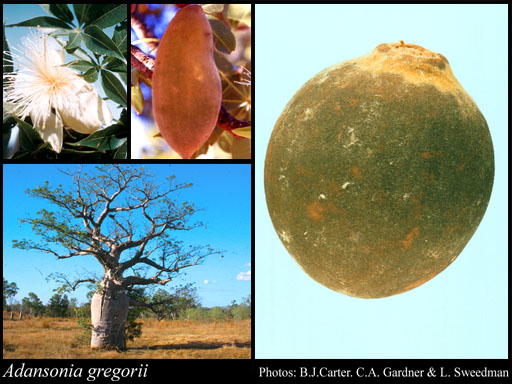- Reference
- Hooker's J.Bot.Kew Gard.Misc. 9:14 (1857)
- Conservation Code
- Not threatened
- Naturalised Status
- Native to Western Australia
- Name Status
- Current
Deciduous tree, 5-15 m high, trunk bottle-shaped. Fl. white-cream, Dec or Jan to May. Sandy & loamy soils.







Scientific Description
Tree, with hairy stems. Leaves 75-110 mm long, 20-55 mm wide, not lobed; margins entire; hairs and scales absent (leaves quite glabrous)with scales absent, Sessile glands absent; stipules present but early deciduous (only visible on youngest leaves). Perianth clearly of two whorls (calyx and corolla), the corolla obvious and prominent. Pedicel present, (20-)30 mm long; glabrous. Epicalyx (extra segments or 'bracteoles' immediately below the calyx) absent. Calyx green, 5.5-6.5 mm long, the lobes free, Sessile glands absent, simple hairs (without tubercle bases) present, scales absent, Terminal appendages absent, number of ribs absent. Corolla white or cream, 68-130 mm long, hairs or scales present, simple hairs (without tubercle bases) present, stellate hairs absent, tubercle-based simple hairs absent, gland-tipped hairs absent, scales absent. Indumentum (outside) Sessile glands absent. Stamens many, united and arising from a staminal tube around the style; filaments present, 45-115 mm long; anthers 1.8-3 mm long, indumentum absent (anthers glabrous). Staminodes absent, appendages absent. Ovary hairs or scales present, simple hairs present, stellate hairs absent, gland-tipped hairs absent; style 1, 50-110 mm long, with five style branches or lobes, hairy for most of length, wing absent. Fruits indehiscent and not splitting into sections (drupes), length-width ratio at least 1.5 times as long as wide, hairs and scales absent, Sessile glands absent; apex rounded; prickles absent (except perhaps a terminal awn); terminal awns or spines absent; calyx deciduous before maturity, not accrescent; carpels 5; seeds per loculus ≥5. Flowering time January, February, March, April, May or December. Distribution Botanical Province Northern, IBRA Bioregion North Kimberley, Victoria Bonaparte, Central Kimberley, Dampierland and Ord-Victorian-Plain.
Distribution
- IBRA Regions
- Central Kimberley, Dampierland, Northern Kimberley, Ord Victoria Plain, Victoria Bonaparte.
- IBRA Subregions
- Fitzroy Trough, Keep, Mitchell, Mount Eliza, Pentecost, Pindanland, Purnululu.
- IMCRA Regions
- Kimberley.
- Local Government Areas (LGAs)
- Broome, Derby-West Kimberley, Halls Creek, Wyndham-East Kimberley.